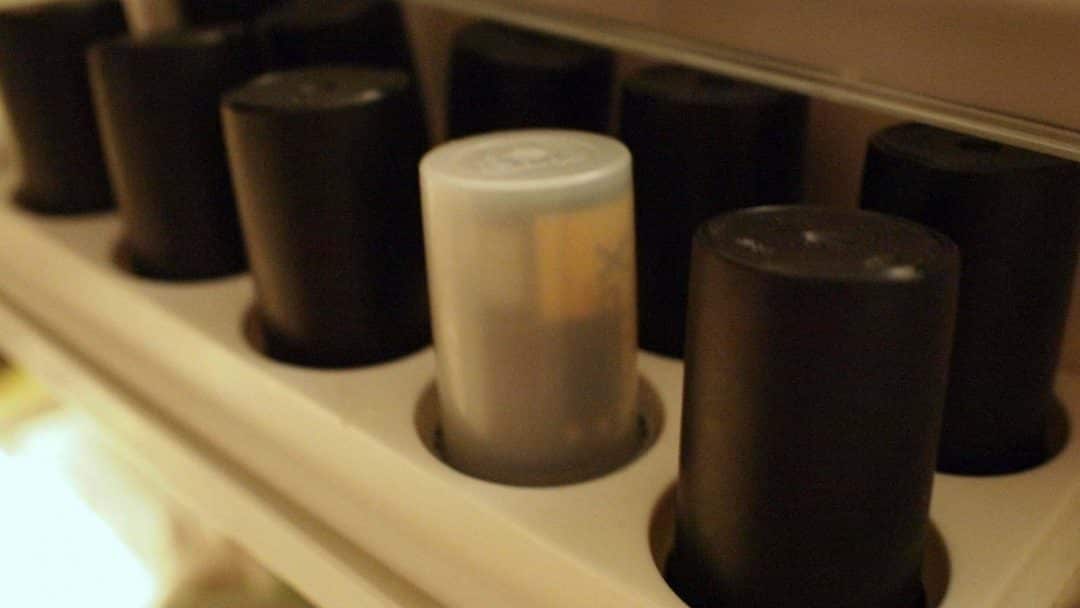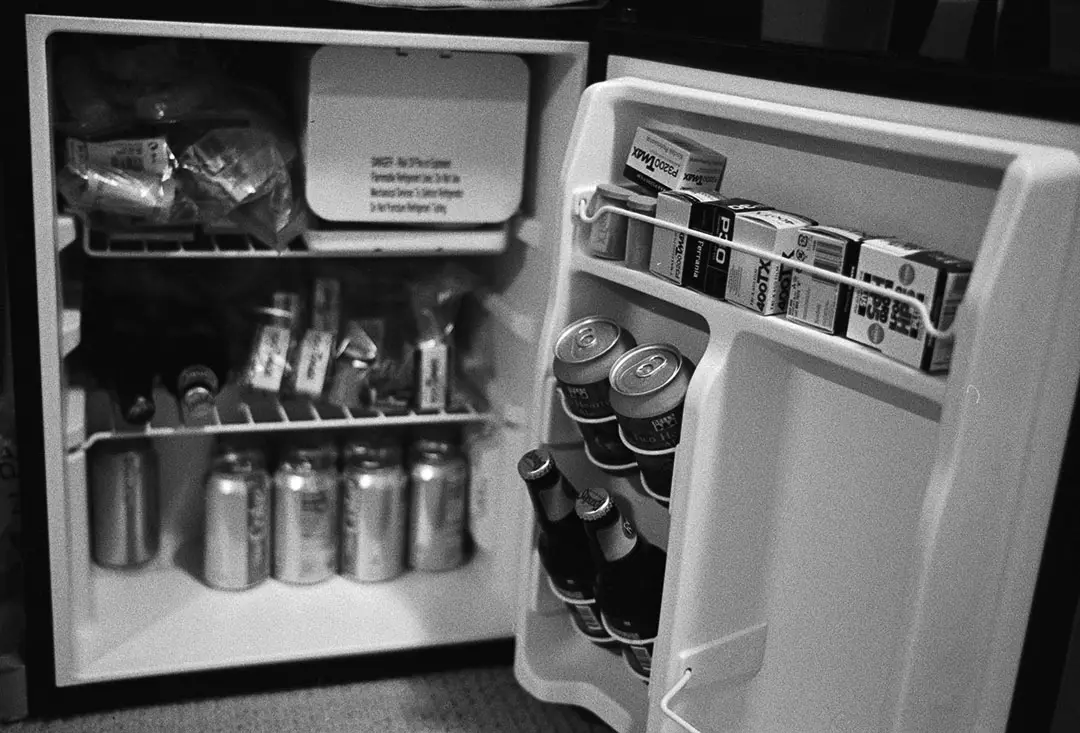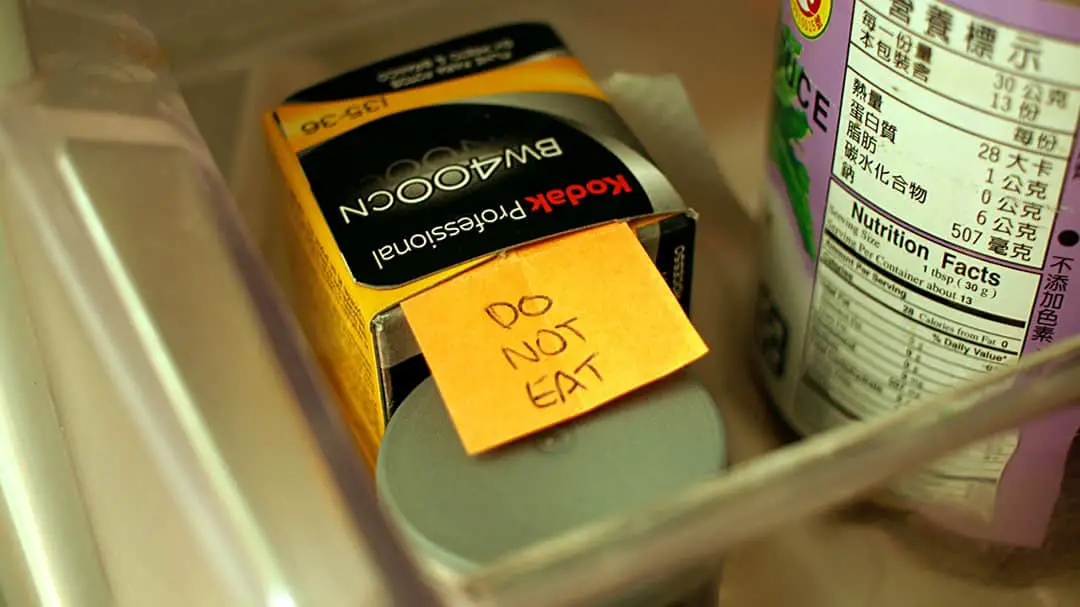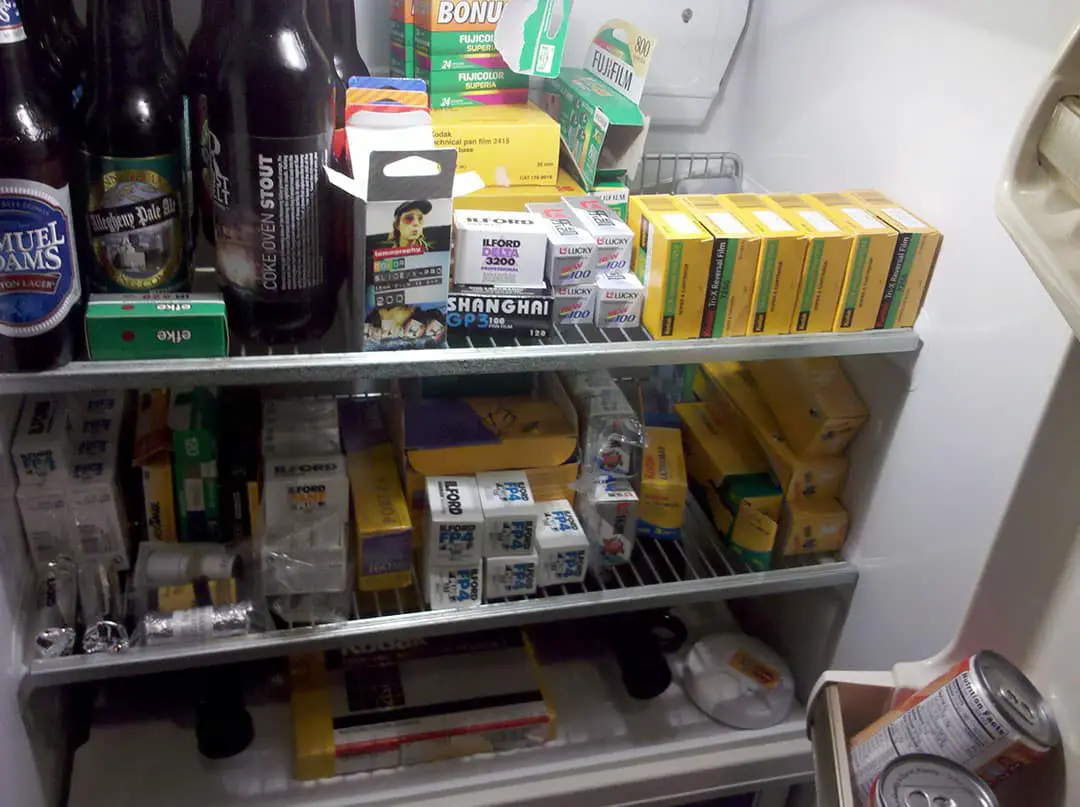There are a surprising number of ways that film can become damaged in your own home.
LearnFilm.Photography took a deep dive into some old Kodak records to find out what exactly are the safest ways to store film for use long term. Many of the documents published by Kodak come straight from the photo engineers who designed their films, and are a treasure trove of information for film photographers.
Here’s what they had to say on the subject of storing film.
As a general rule, film will perform its best when it’s used soon after purchase. Color film should be refrigerated if it’s being stored for up to 6 months, while B&W film can be stored at room temperature. Place color film in the freezer in its original packaging when you need to store it for longer than 6 months.
Keeping the film in the original packaging is important. If it’s taken out of its container and warms up too fast, condensation can form on the film and cause ferrotyping or static buildup.

How long can I store film after it’s been exposed?
One of the big questions that comes up all the time is how long can you store film after it has been exposed?
Kodak’s guidline says professional films may be stored up to a few days after exposure, but that optimal results will be achieved by developing shortly after exposure. Most films can be stored in the fridge for up to six months before processing without forming any noticeable defects.
For cinema film, like Kodak Vision 3 500T, Kodak suggests keeping the film frozen after exposure, and storing for no longer than 6 months. This same recommendation should also apply to Cinestill, which removes the remjet backing from Kodak cinema film to allow processing in C41.
There are many people who discover old exposed, but undeveloped film in attics, basements, or other place. These films, even from the ’30s and ’40s are still developable in B&W chemistry — and most of them even produce decent results. So as long as your film is kept in the fridge, it will be okay.
Why you should develop film shortly after exposing it
To understand why exposed film doesn’t store well, we have to dive into film chemistry. Luckily, it’s not too complicated — here’s the short version:
The film emulsion is made up of silver bromide crystals. When a beam of light hits that silver bromide, some of the electrons in the crystal get excited and become ready to bond with the developer. This is called a ‘latent image.’
The crystals that don’t get hit with enough light will not be able to react to the film developer, because their electrons are not in an excited state.
But if film crystals get struck with enough light, but are left for a long time, that energy can move on to another destination. Film is engineered to keep that energy in the crystals as long as possible, but sometimes the electrons just become bored with that location.
And when that happens, those crystals lose their ability to be developed, resulting in lost details. Where that happens to be the most noticeable is also the same place where those developable grains are needed the most — in the shadows. That’s why you should always develop your films as soon as possible. But you can store the film in the fridge to slightly slow down some of those changes.

How does film change when stored at room temperature?
Fridge and freezer space is precious. If you’re in a small apartment like me, it can be hard to find enough space in the fridge or freezer to store film. But it’s also usually cheaper to buy in bulk, so you can see the dilemma. Probably the best solution is to buy a minifridge for your film, but that’s just another cost to get between you and shooting some sweet sweet film.
So, if you decide to forego putting film in the fridge, what’s going to happen in the long run? Here’s what I learned from reading the Kodak technical information bulletin above.
Both color and black and white film stored in the fridge or at room temperature will lose detail in the shadows, and become noticeably grainier and foggier due to ambient gamma radiation. While B&W films are stable when stored at room temperature, color films will develop color shifts over time.
That said, film stored in the fridge or freezer is still subject to ambient, film-damaging gamma radiation. So while color shifts won’t occur, the film will still become grainier and more contrasty over time. That’s one reason why many photographers don’t store their black and white film stocks in the fridge — it simply won’t have much of an effect. And, if there’s ever a power outage that lasts long enough for the ice to melt, there’s always a chance that some of it will wind up in your film. So storing your film inside a plastic bag while in the freezer can provide an extra layer of protection.
Color positives are by far the most sensitive films to temperature. Because positive films require near-perfect exposures to create a good image, any degradation in the film can be disastrous.

How does humidity damage film?
Humidity is horrible for film. Countries in South East Asia, or other humid areas have to take extra precautions to store their film in a cool, dry environment to avoid water condensing on the film.
In fact, the problem is so common, that Kodak actually made a film stock precisely for this problem. It’s called ProImage 100, and Kodak’s technical datasheet describes it as a punchy film, like Kodak Gold, with “outstanding flesh-tone reproduction, color accuracy, and saturation.” Seriously, it actually says ‘flesh tone’ as if that’s a perfectly normal way to describe film. This document is the reason why we have public relations people writing these things instead of engineers.
But this film is an outlier. Kodak ProImage 100 is the only color film that was designed to be left out of the fridge, in the same drawer where you keep the B&W — even in humid environments.
If you do that with any other film, you’ll risk getting splotchy, experimental rolls, and maybe even a little mold if it’s left too long.
If you’d like to see some water damage, Johnny Martyr did everything right, but still ended up losing a number of rolls after the ice in his film minifridge melted all over his film. The article is also a fantastic musing on why we shouldn’t even be trying to store film for long periods — instead, writing about why he prefers to just continuously shoot film fresh. If you’re shooting film constantly, that’s a real possibility. But when most shooters shoot maybe 10-20 rolls a year, it’s entirely normal to have rolls stocked up over time.
TL;DR: If you live in humid climates, keep your film near a dehumidifier, or just buy a ton of Kodak ProImage.
How does extreme heat affect film?
If you’ve recently found a couple rolls of 35mm film in your car left out in the hot summer sun, this section is for you. Film isn’t meant to stay out in the heat. The layers break down at different rates, causing color shifts. But the other issue is that the film fogs over slightly, losing contrast and sharpness.
If you’d like to see this effect first hand, The Darkroom did an excellent experiment showing exactly how film changes when it’s exposed to heat. They left one roll in the car for two days, and shot it at the same time as a fresh roll. See more about their experiment, here.

How long should I let the film warm up when taking it out of the fridge or freezer?
Film gets damaged when it’s out in the heat, but it also gets damaged if moisture builds up through condensation while the roll is coming up to room temperature. If the film is left in its case, or in the foil wrapping for 120 film, it will warm up to room temperature without any issues. But if the film is taken out of the canister or wrapping too early, there can be some dangerous condensation that builds up.
Kodak’s storage manual also includes a passage about how long to warm up film. Although explain it in a sort of needlessly complex way. Here’s how it breaks down.
135 or 120 Film kept in the freezer for long term storage requires 5 hours to warm up before shooting or developing, while film kept in the fridge requires 3 hours. Loading film in the camera before it’s properly acclimatized can introduce moisture to the film as well as inside the camera body.
Super 8, 16mm, or 110 films don’t require as long to warm up. Because of their smaller sizes, these films can warm up in a single hour from the fridge, or 3 hours when stored in the freezer.
If you get in the habit of loading film too early, it can actually create a perfect habitat for some nasty molds to grow, which will ruin more than just a roll of film. The best case here is always to use fresh film, or film that’s properly acclimatized in a cool, dry environment.
How to store developed negatives?
Film negatives will long outlive digital images if they’re stored properly. The problem that most people run into is that it’s hard to keep them in a safe space. Especially for younger people living in tight apartments, or moving many times throughout their lifetime. Finding an ideal storage method is vital. So what is the best way to store film negatives?
As a general rule, developed film negatives should be kept flat in acid-free plastic sleeves, and stored in a cool, dark place that allows some movement of air. Over time, acetate negatives, like those made by Ilford, Fuji, and Kodak, can develop a vinegary smell, known as ‘vinegar syndrome.’ Once vinegar syndrome starts, it can actually increase the onset speed of vinegar syndrome in other nearby negatives — especially if there is no way for air to escape their container.
Negatives should be stored in a binder or porous container, like cardboard, that is free from volatile household cleaners, mothballs, or stains, or other chemicals used to maintain homes.
For people living in hot and humid environments, it’s important to keep the negatives cool and dry so that the silver gelatin layer doesn’t melt, or become a perfect habitat for mold and mildew. High humidity is typically the largest predictor of how long film will last.
It’s also important to make sure the film is properly cleaned before storing them. Trace amounts of fixer can ruin film over time.
Is it okay to store film in my closet?
Space is super valuable when you live in a small home or apartment. And it sometimes makes sense to have your film stored in the same place as your cleaners and tools. But while that can be efficient, it’s not always the safest environment for film. That Kodak manual also went into some pretty good detail about the kinds of chemicals that break down film emulsions. Here’s what they had to say.
Storing your film in your closet is okay, so long as it isn’t next to certain common household chemicals, like mothballs, ammonia (window cleaners), hydrogen peroxide, furniture polishes, turpentine, or mold/mildew sprays, which can damage film before or after processing.
So there you have it! Keep your film away from the aerosols and other sprays that could potentially break down the film. Sometimes it’s alright if everything is stored in an airtight fashion. But when rolls of film are getting expensive, it’s likely best to keep them away from anything that can ruin a roll. The last thing anyone wants is to shoot something important, only to find too late out their storage method ruined their photos.
Do you have any other tips for how you store your photos? Did I miss anything important? Let me know in the comments down below!

By Daren
Daren is a journalist and wedding photographer based in Vancouver, B.C. He’s been taking personal and professional photos on film since 2017 and began developing and printing his own photos after wanting more control than what local labs could offer. Discover his newest publications at Soft Grain Books, or check out the print shop.

Thanks for the shout-out, very informative article!
No problem! Thanks for your article — it really changed the way I’ve been thinking about buying and storing film.
Hi. I have many, many negatives from when I first started taking pictures, and developing my own black and white, in the early 70’s. I’ve got them in good sleeves and they’re in very good shape. I had been storing them in a “fire-proof safe at my business, but may store some at home.
Most nedia safes, like the one at work, have a one-hour fire rating, meaning that can be in an environment at 1700° F for a certain length of time and maintain an interior temperature of less than 350° F. My question, for which I have been unable to find an answer, is is that adequate for negatives? I suspect the gelatin will be okay but that they emulsion with degrade and the image will suffer. The negative sleeves may melt and fuse with the negatives.
Any ideas?
Thanks. Great article too!
Hi Robert,
Thanks for that! I actually just published an article on the topic of storing negatives long-term yesterday. The one downside of using something like a fireproof safe is that it will trap the air in tightly. Over time, especially acetate-based negatives may start breaking down and will form acetic acid, which smells like vinegar. Once that starts happening, if there’s no way for the gasses to escape, they can actually cause the other negatives to start breaking down as well. The best way to store film negatives long-term is in a fridge that can control humidity down to 20%. But that’s more so for museums and archives that are storing precious negatives.
For regular people, the best way is to store them in something porous, like in binders or cardboard boxes, so that if one set of negatives do develop that vinegar syndrome, one bad apple won’t spoil the bunch.
Hope that helps!
Daren
Are Neutral fixer (ecopro) and caffenol/vitC/washing soda developer the least water quality destructive components in B&W film and direct positive paper processing? Is there less bad toner too?
Yes, caffenol and ecopro will be the least damaging overall, but you could also look into Xtol which is a pro developer made with vitamin C as well — it’s the last developer that was ever made with the incredible research funding that was available to Kodak at the height of the film era. So it’s the most environmentally friendly commercial developer, and it also imparts some good contrast, while pushing/pulling film extremely well. That said, for paper developing, it can exhibit a slight speed loss since it’s designed for film.
For toner, unfortunately Sepia and Selenium are pretty well the only affordable options that actually tone the silver in your prints. But it is completely possible to tone your prints with coffee and tea, which can change the color of the paper in some cool ways. The process takes a bit longer, but it’s a lot of fun to experiment with.